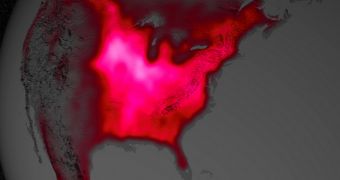A group of scientists from the Freie Universität Berlin, in Germany, argues in a new study that the Midwest portion of the United States displayed the highest level of photosynthetic activity in the world during the last growing season. These results are based on an in-depth analysis of satellite data, the team reports.
The work was only focused on the Northern Hemisphere during the growing season, so no relevant data is available for the Southern Hemisphere. Researchers from NASA worked together with colleagues from a number of universities in the United States for this investigation.
The fact that photosynthetic activity levels can be teased from satellite data was first demonstrated by scientist Joana Joiner, from the NASA Goddard Space Flight Center (GSFC) in Greenbelt, Maryland, last year. The new study was led by FUB investigator Luis Guanter, and is detailed in a paper published in the March 25 issue of the journal Proceedings of the National Academy of Sciences (PNAS).
This is the first time that satellite data are used to assess photosynthetic activity from agriculture. Its conclusions should not come as a shock, since the Midwest is known to be an extremely fertile area. Photosynthesis was used as a criterion because it provides a clear picture of how much sunlight plants over a given area are capable of converting into energy.
“The paper shows that fluorescence is a much better proxy for agricultural productivity than anything we've had before. This can go a long way regarding monitoring – and maybe even predicting – regional crop yields,” says Christian Frankenberg, a co-author of the PNAS paper, and a researcher at the NASA Jet Propulsion Laboratory (JPL), in Pasadena, California.
Joiner, Guanter and Frankenberg first started working together on this research after meeting up at a workshop held in 2012 by the Keck Institute for Space Studies at the California Institute of Technology (Caltech) in Pasadena. Caltech manages JPL for NASA Headquarters in Washington, DC.
Their analysis of global photosynthesis levels have revealed that the tropics are indeed very active in this area, but not as much as the Midwest's Corn Belt. The Midwest “really stands out. Areas all over the world are not as productive as this area,” Frankenberg explains.
The dataset the researchers used for this study was produced by the Global Ozone Monitoring Experiment 2 (GOME-2) instrument on the European Space Agency's (ESA) Metop-A meteorological satellite. A careful interpretation of the data was required in order to prevent any errors, the group says.
“Corn plants are very productive in terms of assimilating carbon dioxide from the atmosphere. This needs to be accounted for going forward in trying to predict how much of the atmospheric carbon dioxide will be taken up by crops in a changing climate,” Joiner concludes.

 14 DAY TRIAL //
14 DAY TRIAL //